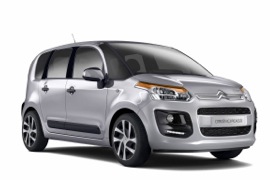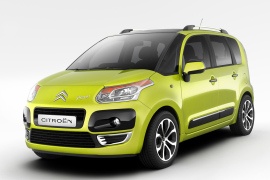CITROEN C3 Picasso Models/Series Timeline, Specifications & Photos
First production year: 2008
Engines: Gasoline, Diesel
Body style: Hatchback
Citroen introduced a facelift for the C3 Picasso in 2013, preparing it for the upcoming Euro6 standards that came into force in Europe in the Fall of 2014.
After five years on the market, the C3 Picasso was finally updated by the French automaker, which was not in a very solid financial situation. Moreover, the small-sized MPV was not a hot cake, and its sales were way below expectations. So, a change in its look and improved engines were performed. But, unfortunately, that change didn't transform the car into a best seller.
On the 2013 model, the C3 Picasso sported a new front fascia. Thus, Citroen added a chromed trim on the upper side of the bumper and integrated the "double-chevron" badge on it. Also, the lower side was redesigned and sported LED daytime running lights placed underneath the fog lamp' clusters. But the automaker didn't stop there and also improved the look of the taillights, which got clear lenses.
There were more changes on the interior, with improved materials and a new sat-nav system placed atop the center stack. Like its predecessor, the C3 Picasso featured an instrument cluster mounted in the dashboard's center, so even those seated in the back could read the speed. The rear split-folding (60/40) bench had a sliding function that allowed owners to get more space for the luggage area.
Under the hood, Citroen introduced the 1.2-liter turbocharged gasoline engine in the lineup. Still, the base model featured a 1.4-liter naturally aspirated powerplant. There were also two turbo-diesel versions. The automaker mostly offered the car with a manual gearbox. However, a six-speed automatic was available at extra costs for specific versions.
Citroën introduced the MPV version of the C3 at the 2008 Paris Motor Show, trying to get the most out of its small-sized vehicle platform.
With the world financial crisis starting to unfold and affect the automotive industry, Citroën was desperate to survive in a falling down to pieces market. The market was shrinking, and automakers had two choices: either launch new vehicles with less expensive investments or hold on to their old models. Citroen took the middle road by launching a new car based on an existing platform.
Citroën's design department tried to create a vehicle that could fit a family and enough luggage in a small-sized car. For that, it needed to design a short front overhang, a tall greenhouse, and a flat rear end. For that, it made the C3 Picasso with rounded shapes that make the vehicle looks bigger. At the front, the headlights sported eyebrows-like blinkers placed on the upper side of the headlights. In addition, those were placed higher for better protection against shopping cart hits or tight parking spots. At the back, the C3 Picasso sported high-mounted taillights extended from the D-pillars to the wide tailgate.
Inside, the carmaker installed plenty of storage areas in the dashboard, under the front seats, overhead compartments, and, of course, on the door cards. To lower the manufacturing costs for both left-hand drive and right-hand drive versions, Citroen placed the instrument panel atop the dashboard in the middle section. The automaker created enough legroom for everyone, thanks to the high-mounted seats.
Under the hood, the French carmaker installed a wide engine range, both gasoline and turbo-diesel, fitted with either manual or automatic transmissions.

